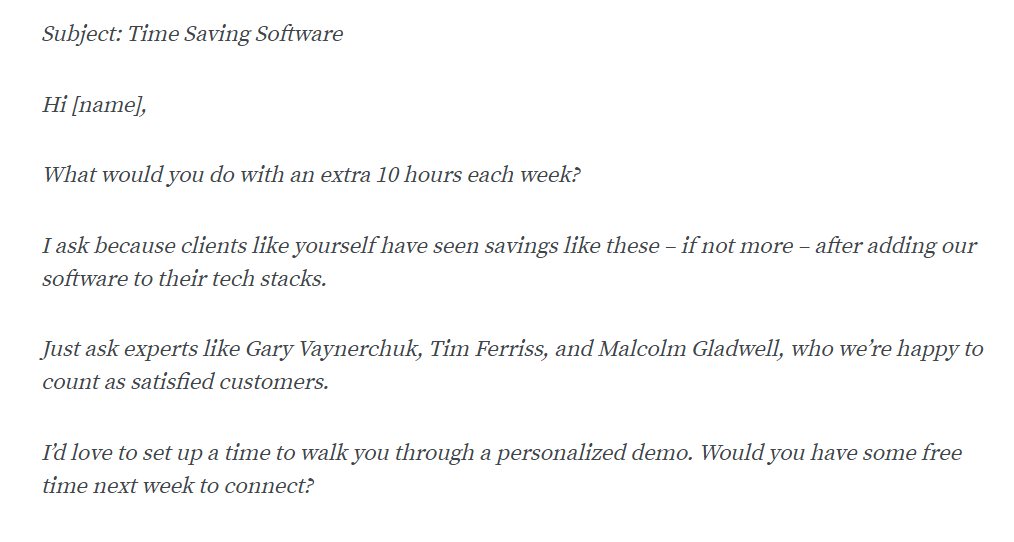There are plenty of copywriting models out there, but one that’s stood the test of time is AIDA – attention, interest, desire, and action.
Here’s how each of these four elements works together:
- Attention – You can’t sell someone if you don’t have their attention.
- Interest – You need to hold that attention long enough for readers to develop an interest in your product or service.
- Desire – While you have their interest, speak directly to their desires.
- Action – Show them how to turn their desire into action (usually by purchasing).
Let’s break each step down in more detail to see how it applies to any sales copy you create.
Using AIDA in Sales Copy
Attention
The key to capturing attention is knowing who your audience is. Different audiences react in different ways. What works to engage one won’t make a dent with another.
If you’ve created buyer personas in the past for your target customers, you should have some insight into their passions and problems. Drawing on that, write your copy using the words and techniques that are most likely to capture their attention and spark engagement.
That might mean:
- Personalizing your copy to their needs.
- Provoking their curiosity to learn more.
- Creating a sense of urgency.
- Showcasing a special offer.
Interest
For most copywriters, capturing attention is fairly easy. But think about how many times you’ve clicked away after opening a sales email or landing on a sales page. Holding attention by generating interest is often much harder to do.
The key to holding interest is to structure every line you write so that the reader wants to continue onto the next line.
There are a number of ways you can do this. You can:
- Invest in creating an engaging opening sentence or paragraph.
- Weave stories throughout your copy.
- Clearly demonstrate that you understand the pain points your audience is experiencing.
- Work humor in (when you can do so appropriately).
- Share interesting facts, data points, or statistics that are relevant to your offering.
Once you have an initial draft, give each line a closer look. If it doesn’t offer a clear reason to keep reading, rework it into something more compelling.
Desire
As you’re reviewing your copy, make sure you’ve clearly defined how your product or service will either solve readers’ problems or make their lives better in some way. If they don’t feel that they’ll gain pleasure or avoid pain by working with you, you aren’t going to spark the desire necessary to convert readers into customers.
This is where you’ll put time-tested copywriting practices to the test. Sell your benefits, not your features. Explain clearly what’s in it for readers. Use persuasive, motivating language to the extent possible.
Take the example below from Expression Fiber Arts:

Can you see all the different ways the ad copy evokes desire? Among others, there’s:
- A limited time only offer
- Discount coupon codes
- A mention of scarcity
- Callouts to specific types of projects where the product would work well
- Eye-catching imagery
Action
Finally, there’s the cornerstone of sales copy: the call to action (CTA).
Keep it simple, but keep in mind that people need to be guided. They need to be told what to do. A CTA button or clickable link shows them how to take the next step in order to act on all the desire they’ve built up for your offering.
Examples of AIDA Sales Copy
Although the AIDA model may have been developed by traditional copywriters, it’s used much more broadly today. Here are a few examples to get you inspired:
AIDA Sales Email
Take a look at the sales email template below for an example of AIDA in action:

Here:
The sentence, “What would you do with an extra 10 hours each week?” captures attention.
The following sentence sustains interest by suggesting that this benefit isn’t just theoretical – it’s actually possible for the reader.
The use of influencer names further heightens the desire created by the earlier descriptions of benefits.
The closing CTA, “Would you have some free time next week to connect?” offers a defined next step.
4 Tips to Succeed Using the AIDA Formula
As with any new approach, it takes time and practice to use the AIDA formula successfully . The four tips below will help short-cut your learning curve:
If you don’t already have an ideal buyer persona, start there. Use organic Google search results, social media activities, and engagement data from your website and customer records to build an ideal customer persona.
Work on your subject lines and opening paragraphs. If you only have the time to improve one part of your copy, make it your subject line or opening paragraph. If you can’t generate initial attention and interest through these elements, it doesn’t matter how effective your later copy or your CTA is.
A/B test your copy. As a copywriter, you have a virtually infinite number of options to use at each stage of the AIDA formula. Do you capture attention by including the recipient’s first name in a sales email subject line? Which particular pain point should you speak to in your headline? Without the data generated by an A/B split test, you’ll never know for sure.
Make sure your target audience knows who your brand is and what it does. Every stage of the AIDA process is more effective when you’ve already established brand awareness. Invest in broader digital marketing campaigns while also dialing in your sales copy using the AIDA model.
Putting It All Together
Following the AIDA formula doesn’t mean rigidly structuring your copy into four distinct stages. Even though the four do tend to build on each other when executed well, how exactly you cover each element in the process will depend on your company, your product, and your audience.
If you’re starting fresh with new copy, use the AIDA model to guide your process. Or, if you’re attempting to make existing copy more effective, making sure you’ve spoken to each of these four needs will go a long way towards driving the results you hope to see.
Test out the AIDA model. Watch your analytics. Iterate based on the results you’re seeing. With time, you’ll benefit by capturing attention, holding interest, provoking desire, and producing action.
Want to help contribute to future articles? Have data-backed and tactical advice to share? I’d love to hear from you!
We have over 60,000 monthly readers that would love to see it! Contact us and let's discuss your ideas!
